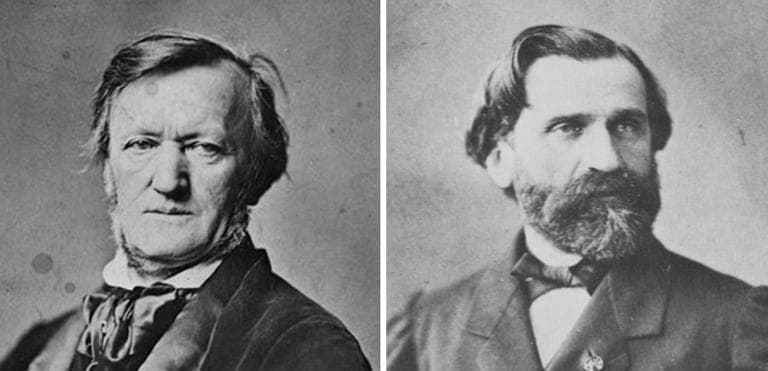Advertisement
Verdi Vs. Wagner, And Why They Disliked Each Other's Music
Resume
There have been documentaries and celebrations for 100 years since the premiere of The Rite of Spring, but this year also would be the 200th birthday of the opera composers Giuseppe Verdi and Richard Wagner.
Verdi, who was Italian, wrote operas that are continually performed by major opera companies. His most famous works include "Aida" and "La Traviata," about a woman who must decide whether she loves a man enough to give up her carefree ways.
Wagner was a German composer with a much more checkered life. He was usually in debt, he was an anti-Semite, he was a womanizer, and yet he composed operas of staggering creativity and ambition. Most famous among these are the cycle of four operas collectively known as "The Ring Cycle," and "Tristan und Isolde," about two doomed lovers.
"Wagner was known to abhor grand opera. And Verdi was known to say that Wagner often went down an avenue that was unnecessary."
William Lumpkin
Not fans of each other's work
It goes without saying that although both Verdi and Wagner wrote operas, their operas sounded very different. And it turns out, they weren't each other’s biggest fans.
“It’s interesting to me that these guys were contemporaries of each other,” said William Lumpkin, the director of the Opera Institute at Boston University. “According to what I know, they actually never met, but they certainly knew of each other, and perhaps didn’t have the greatest respect for what each other was doing. Wagner was known to abhor grand opera. And Verdi was known to say that Wagner often went down an avenue that was unnecessary.”
It's still a common criticism of Wagner — that his operas are long-winded and bombastic.
Verdi's opera style
So what does grand opera — the opera tradition that Wagner abhorred, and in which Verdi came from — sound like?
“Italian opera was really written with the singers in mind,” explained Lumpkin. This meant operas showed off singers’ skills, and included beautiful, soaring melodies. The singing style itself is called “bel canto,” which translates to “beautiful singing.”
Lumpkin summarizes it this way: “Italian opera — and opera in general — was for entertainment purposes. People came, they heard the singer, the singer hit the high note, applause.”
- Renée Fleming performs in Verdi's "La Traviata," Los Angeles Opera, 2006
Wagner's opera style
This was very different from how Wagner viewed opera. He thought of opera as a “social ritual in which people came together to witness this huge, massive scope of an artistic venture,” Lumpkin said.
This is the idea Wagner called “Gesamkuntswerk,” which translates to the total art work. “All things coming together for one objective,” Lumkpin said.
Gesamkuntswerk meant that Wagner wanted total control of his opera: he wrote the words, he wrote the music, he was involved in staging and lighting, he even created a performance space where only his operas would be shown. This place still exists in Bayreuth, Germany, and the Bayreuth Festival celebrating Wagner still continues.
- Waltraud Meier performs in Wagner's "Tristan und Isolde," La Scala, 2007
The unending melody
Wagner was influenced by the philosophy of the German philosopher Arthur Schopenhauer, who believed that man is motivated by an unrequited desire that will only ever be unsatisfied.
One compositional technique Wagner used to illustrate this idea is called “the unending melody,” Lumpkin explained.
In music, there are musical moments called cadences. If you think of a musical phrase as analogous to a sentence, cadences act as punctuation marks. Usually, a cadence acts as a period at the end of a musical sentence.
The Tristan chord
One of the most famous cadential moments in Wagner’s oeuvre, and in Western classical music, is called the Tristan chord because it occurs extensively in Wagner’s opera Tristan und Isolde.
“This chord, in and of itself, is not new,” Lumpkin explained. “Beethoven used it, Mozart used it, but it was always within a sort of cadential structure ... in this moment it is very unprepared and unstable.”
What Wagner did that was new and different and exciting — and the reason the chord bears his opera’s name — was that he veered from that prescribed path.
Instead of resolving the chord to a resting point as Beethoven or Mozart might have done, Wagner left the Tristan chord unresolved. By doing this, Wagner created the feeling of unrequited longing, which is a major theme in Tristan und Isolde, and in Wagner’s works more generally.
Guest:
- William Lumpkin, director of the Opera Institute at Boston University.
This segment aired on June 19, 2013.

